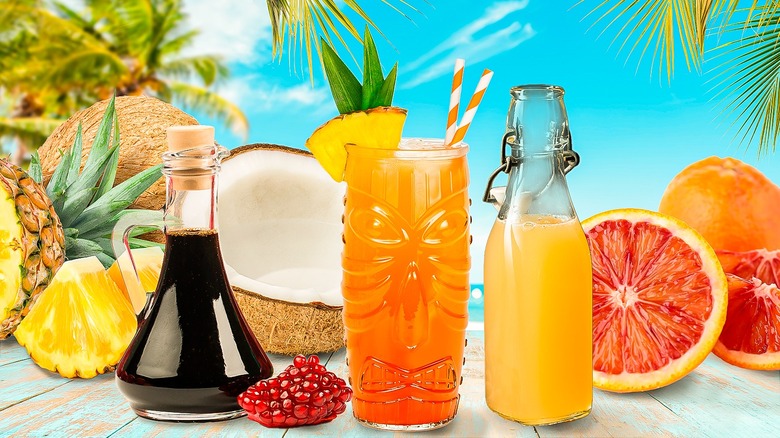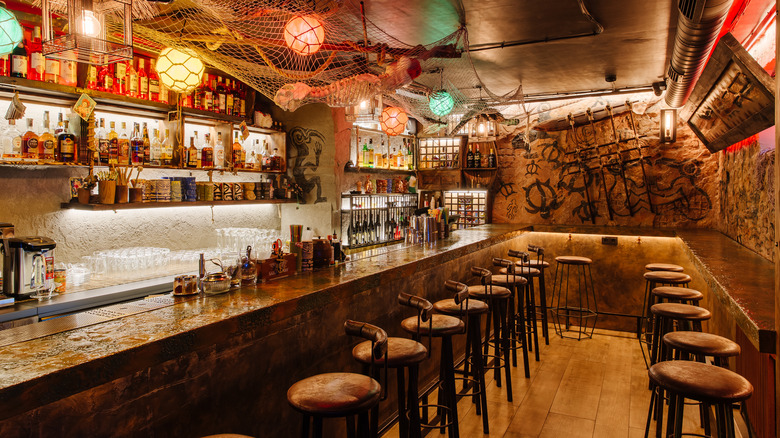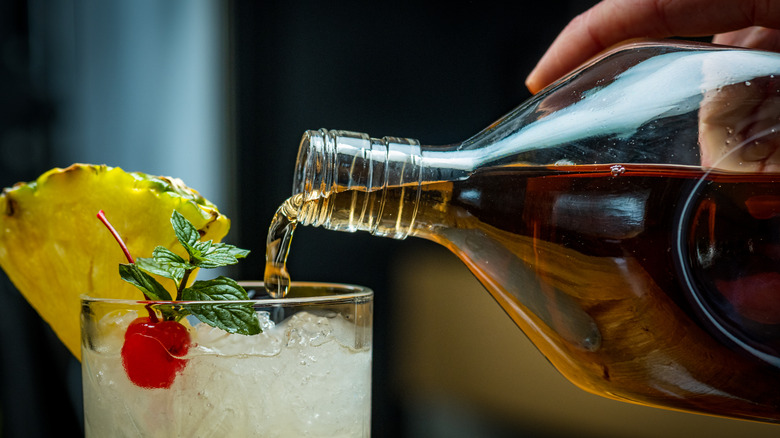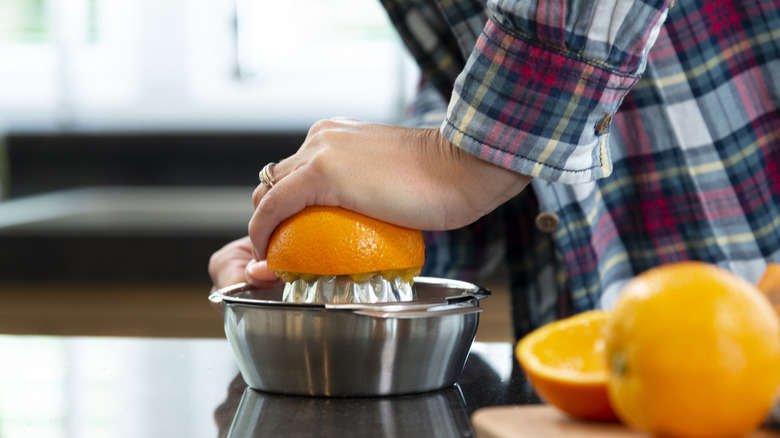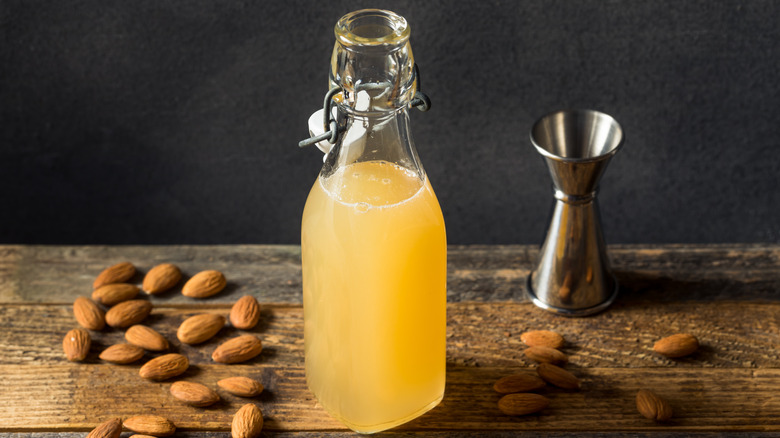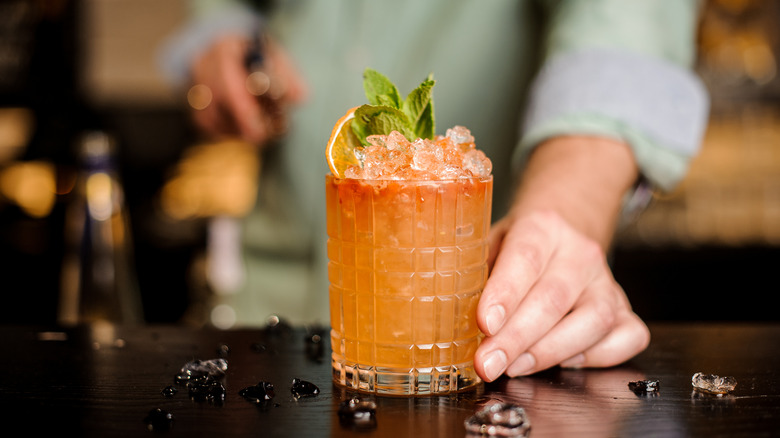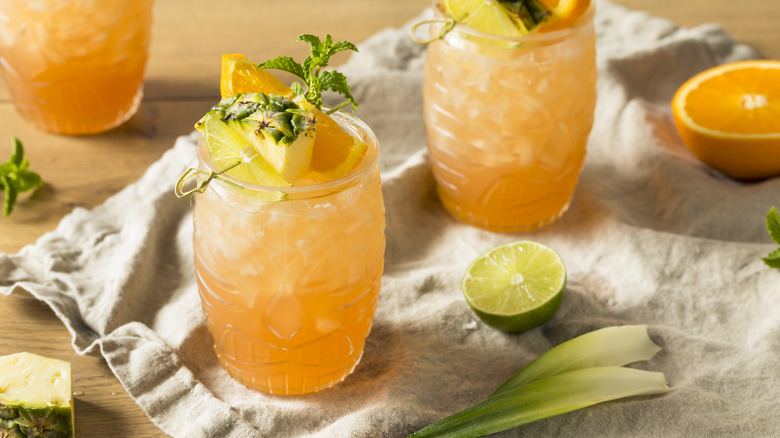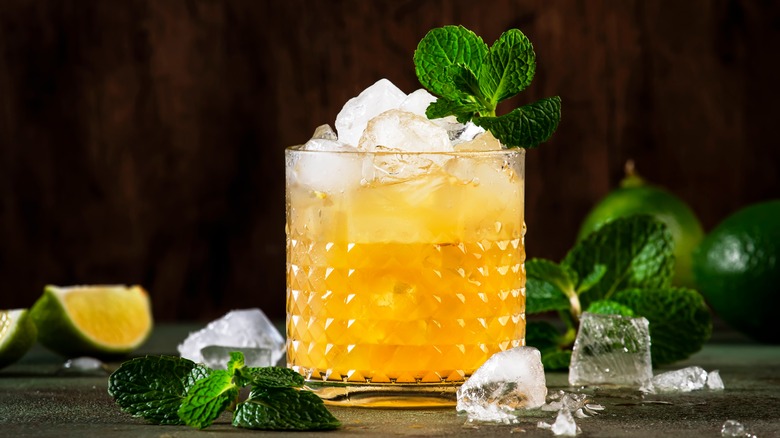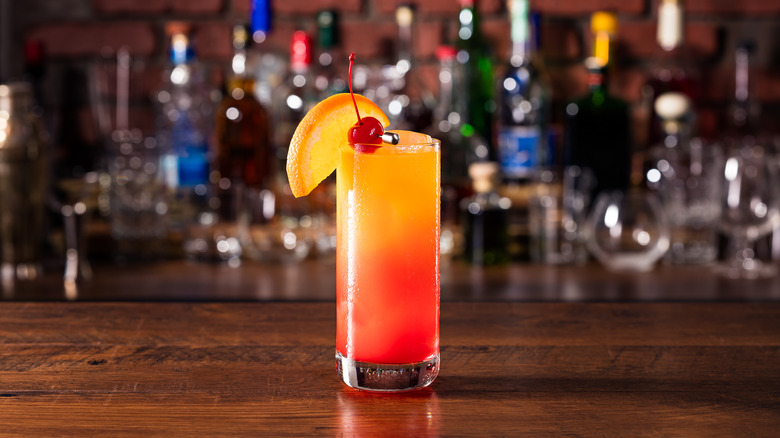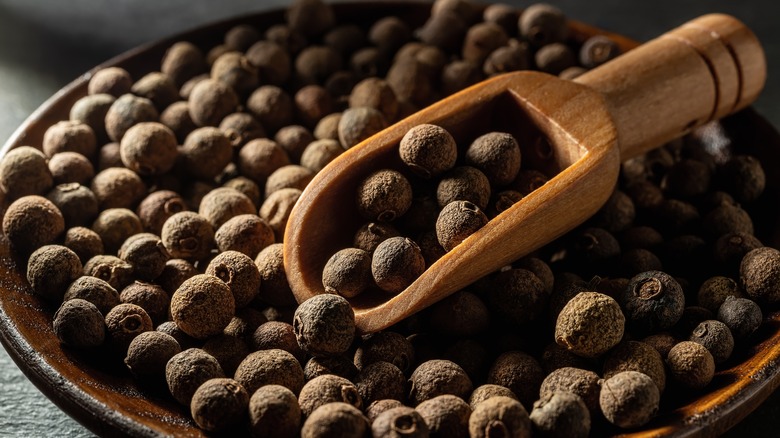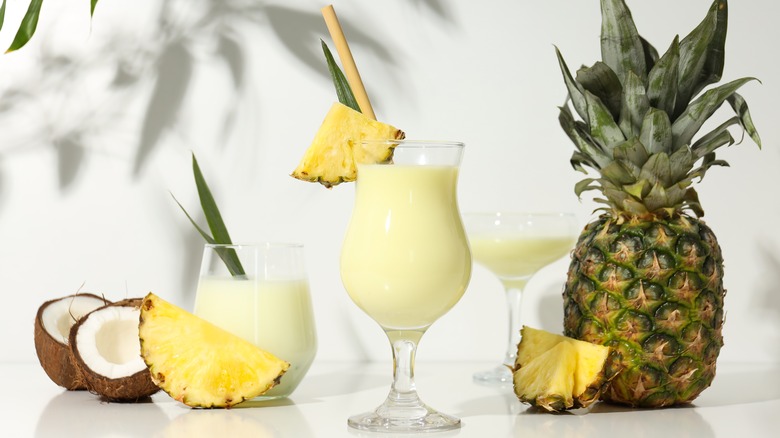9 Must-Have Ingredients To Make Tiki Cocktails At Home
Getting a drink at a tiki bar is a vibe, just ask Don the Beachcomber or Trader Vic. From the bamboo décor and breezy music to the kitschy glassware, giant punch bowls, and over-the-top (and sometimes flaming) garnishes, it's more than just stopping for a drink: It's an experience.
If you've looked closely at the cocktail menu at a tiki bar, the long list of ingredients in some of the most famous drinks can make it feel impossible to recreate your favorites at home. (If you're anything like us, it can be overwhelming enough to invoke the "close your eyes and point" method of ordering.) But when you peel back some of the flashy layers and focus instead on nuanced tropical flavors, you'll find that bringing that vacation vibe home isn't such a tall order. With some surprisingly approachable and versatile ingredients, your house will be the new go-to spot for Zombies and Penicillin.
Why should you trust me? During my time as the co-owner of a restaurant and specialty cocktail bar, working alongside world-class mixologists, I made sure to put some of the genre's classics on our beverage list — and narrowed down the bevy of ingredients to the must-haves that belong behind any tropically-leaning bar. So grab your shaker, crushed ice, and a few paper umbrellas (don't worry, you don't need a lighter) and get ready to take your cocktail-making game to the beach.
The history of tiki cocktails, and the tools you need to make them
Tiki drinks have a complicated history, rife with post-war cultural appropriation and influenced by colonialism, particularly in the South Pacific. Many modern bartenders are shifting their focus from tiki to tropical, skipping the glassware shaped like Māori deities but holding on to the fruity flavors and visions of sipping a drink with your toes in the sand. Thankfully, cups shaped like pineapples and edible orchid garnishes are sticking around.
Of course, you can't talk tiki — or tropical — drink history without mentioning Don the Beachcomber and Trader Vic's. These two iconic bars (yup, they're places, not people — though the founder of Don the Beachcomber did legally change his name to Donn Beach) are part of the origin of tiki culture in America. The Mai Tai most likely got its start at Trader Vic's, while adding Angostura bitters to fruity drinks was a hallmark of a Don the Beachcomber beverage before it went mainstream.
To make the drinks that came out of these and many tiki bars after, you'll need a few simple but important tools. In addition to a shaker, strainer, stirring spoon, and jigger, you'll want a juicer — either a reamer, handheld juicer, or electric juicer if you're mixing drinks for a crowd — and a sharp paring knife and cutting board for those fancy garnishes. And if a frozen drink is calling your name, make sure your blender is plugged in and your ice is cool.
Rum
Is it even a beach cocktail if it doesn't have rum in it? Many tiki beverages call for multiple styles of this sugarcane liquor in a single drink, so it's important to have a variety available. According to "Death & Co Welcome Home" by Alex Day, Nick Fauchald, and David Kaplan of the famed Death & Co bars, there are four categories of rum that you may want behind your bar.
Spanish-style rums are lighter, distilled from molasses, filtered to be less fiery, and are commonly made in former Spanish colonies. English-style rums are richer, often distilled from Demerara sugar, and are popular in present-day territories of the United Kingdom. French rums, also known as rhum agricole, are distilled from fresh sugarcane juice instead of molasses, are known for grassy and earthy notes, and are produced in particular in Martinique. Jamaican rum is a tiki icon but is also hard to come by. It is made in pot stills, and has a richness and funky complexity that early tiki cocktails were built on.
When it comes to age, stick to younger rums unless the recipe calls for an aged rum. Mixing aged rums with fruit juices and syrups could overwhelm the rum's complexity, so save those older bottles for sipping. Proof is also a factor. Overproof rums are known for their fragrance and rich mouthfeel, which can help bring balance to your drink — and your piña colada just wouldn't be the same without a float on the top.
Fruit juices
After rum, it's fruit juice that comes to mind when someone mentions tiki cocktails. Pineapple, orange, and lime reign supreme, and lucky for home bartenders, they're all easy to come by.
No matter which juice you're using, the fresher your juice, the better your cocktail. Juice citrus fruit like lime, orange, lemon, and even grapefruit just before making your drinks, as they'll start to lose their acidity if you keep them around too long. For bottled fruit juices (never lemon or lime, though), read the labels and seek out the freshest juices with little to no added sugar, preservatives, or watery filler. You'll want punchy, fruity flavor in every sip, after all.
If pineapple is your flavor of choice, consider looking beyond the piña colada and instead mixing up a Painkiller. Pineapple is the star, with a little added sweetness from the orange juice and a sprinkle of nutmeg to warm it all up. Do you love the tart bite of passion fruit? Turn to New Orleans' addition to the tiki codex and pour yourself a Hurricane. Check the freezer section for passion fruit purée, and if you can't find it at your go-to grocery store, visit your local Latin market. Orange juice is the backbone of the Bahama Mama, an approachable tiki drink that's also easy to make. It's the perfect way to say welcome to the islands — or just welcome to your backyard.
Orgeat
Tiki cocktails can be surprisingly creamy, with a nutty note you might not recognize, and you've got orgeat to thank for that. Traditionally, orgeat — pronounced or-zha — is made with almonds, sugar, and rose or orange flower water. Pro tip: If you've got a nut allergy, keep an eye out for this ingredient, as almost all orgeat (both commercial and homemade) contains nuts.
The flavor of orgeat will vary depending on the brand you purchase. Some are sweeter, with a flavor more akin to marzipan, while others have a bitter almond note that brings more complexity to a drink. You're likely to find orgeat from the French brand Giffard at your liquor store, or you can seek out boutique products like the orgeat from Liber & Co in Austin, Texas, or pecan-based Creole orgeat from El Guapo in New Orleans, Louisiana.
Pecan-based orgeat? Turns out you can make orgeat out of just about any nut, and many bartenders — professional and at-home alike — are doing just that. Changing the nut will change the flavor profile of your drink, allowing you to customize your cocktail. Use pistachios for a subtle green hue and a more savory flavor, sub hazelnuts for a toasty note, or stick to classic almonds, but make your own orgeat for your next batch of Mai Tais or scorpion bowls.
Orange liqueur
When it comes to orange liqueur, a little goes a long way in adding a note of citrus and some extra sweetness to a drink. But varieties of orange liqueur aren't all the same, and the influence each has on your cocktail depends on what bottle you're pouring from. Triple sec is the most straightforward orange liqueur. The most popular brand is Cointreau, which defines its product as a liqueur made with sweet and bitter orange peels. All triple secs are orange liqueurs, and triple sec does not contain any other flavors. It's a popular choice for margaritas and cosmopolitans.
Like Cointreau, curaçao (a tiki bar essential!) is made from a neutral beet sugar spirit and orange peels, but curaçao includes additional herbs and spices. Those spice notes (often vanilla, cinnamon, or black pepper) help give drinks made with curaçao a tropical vibe that is unmistakably tiki. And no, the color doesn't matter, so if all you've got is blue curaçao, you're still good to go. Finally, Grand Marnier is an orange liqueur that's made with cognac and neutral spirits instead of just a neutral beet sugar spirit. Using cognac adds notes of vanilla, hazelnut, and toffee.
Most cocktail recipes will call for a specific orange liqueur, though they're fairly interchangeable. But if you're shopping specifically for tiki drinks, curaçao is the one. Popular brands include Pierre Ferrand Dry Curaçao and Clément Creole Shrubb (made with a base of rhum agricole).
Falernum
Falernum is a unique cocktail ingredient that is basically tiki in a bottle. Hailing from Barbados, falernum is a liqueur made with lime, sugar, spices (usually cloves, cinnamon, nutmeg, ginger) and almonds. It has a low ABV (alcohol by volume), with the alcohol acting more as a preservative than a flavoring agent, though non-alcoholic syrups are also available.
You may have seen Velvet Falernum listed as an ingredient on a cocktail menu, but it's not a different product — John D. Taylor's Velvet Falernum is one of the most common brands of falernum available, so the name is sometimes used interchangeably. While more boutique liqueur producers are crafting and bottling falernum, it can still be hard to come by, making this a good tiki ingredient to make at home. Combine toasted almonds, lemon zest, and spices with rum and allow it to infuse, then add a lime simple syrup to bring it all together.
Falernum really defines the Zombie, as well as the Three Dots and a Dash. For a lighter drink with tiki vibes, shake some falernum with ice and top it with tonic or soda water. You can also swap falernum in for simple syrup to give your other drinks a beachy, slightly spiced note — it's great in a daiquiri and would add extra depth to a mezcal margarita.
Angostura bitters
Angostura bitters were developed by Dr. Johann Siegert in the 1820s in Angostura, Venezuela, originally as a medicinal tincture for Venezuelan soldiers. By the 1850s it was being exported to England, the Caribbean, and the U.S., and the bitter elixir found its way into cocktails quickly.
The bitters are an essential part of an old fashioned or a Manhattan and are often seen as a garnish atop foamy whiskey sours made with egg whites, making them a must-have for any bar. You might be surprised to know Angostura bitters are also an important ingredient in some of your tiki favorites. Dark red Angostura bitters impart a flavor of cloves, cinnamon, and herbs, a flavor profile that — along with bright tropical fruit — defines tiki cocktail culture. They are featured in a Mai Tai and a Queen's Park Swizzle. The spice notes are just as great with rum as they are with whiskey, giving cool and fruity cocktails a touch of warmth that will take you straight to the beach.
While Angostura bitters do contain 44.7% ABV, it only takes a few drops to impart major flavor, making it a common addition to low-proof cocktails. If you're mixing up non-alcoholic tiki cocktails, consider a dash or two of Angostura to add some of the depth and spicy notes that alcoholic drinks often get from rum. And for those looking for a truly zero-proof alternative, look to Ritual Zero Proof or All the Bitter for similarly spicy (but completely alcohol-free) options.
Grenadine
It's not just for Shirley Temples! The mention of grenadine may conjure up images of bright red kiddy mocktails or an artificial-tasting Tequila Sunrise, but if you upgrade to the good stuff (or just better than bottom shelf varieties), you'll realize this fruity ingredient can do a lot more than turn your drink pink.
First things first, grenadine is not cherry flavored. Grenadine actually gets its bright flavor and vibrant color from a much larger fruit with a sophisticated reputation: pomegranate. To make grenadine, pomegranate juice is reduced with sugar and sometimes orange peel or orange blossom water to create a concentrated, tart syrup. Many commercial grenadines focus more on corn syrup and coloring than pomegranate, which explains why it's usually associated with cheap cocktail cherries instead of the stunning (if hard to eat) fruit. The good news? Real grenadine is easy to make at home, and you won't miss that old bottle of Rose's once you taste the real deal.
So what do you do with homemade grenadine? In addition to making a totally grown-up Shirley Temple or the best Dirty Shirley you've ever had, it will give your tiki drinks a bright hue and a touch of tart sweetness that would be extra refreshing with your toes in the sand. Use grenadine in a Singapore Sling, Bahama Mama, or Rum Runner.
Allspice dram
Allspice is ... confusing. It isn't actually a mix of all your baking spices (though its flavor does bring to mind a combination of cinnamon, nutmeg, and cloves, hence its name). In reality, allspice is the berry of Pimenta dioica, an evergreen tree native to the West Indies, Central America, and Southern Mexico (you know, all the places you dream of while you're drinking tropical cocktails). It can be used in baking, to add depth to marinades and pickling brines, or to make allspice dram.
Allspice dram is a spiced — and spicy — concoction of allspice berries steeped in rum and sweetened with sugar. The spice is commonly used in Jamaican cuisine, and tiki pioneers looking for ways to bring island flavor to their drinks brought allspice behind the bar to balance out sweet juices and bright citrus. It gives tiki drinks a tropical je ne sais quoi, or it can be sipped on its own as a wintery after-dinner drink.
St. Elizabeth's Allspice Dram is one of the most popular commercially produced versions, though even that can be hard to come by. Thankfully, it's fairly easy to make at home. Once you've got some, use it to spice up your Ancient Mariner — allspice loves grapefruit — or a Rum Barrel. Feeling cozy? Use it to add warmth to a Lion's Tail (which combines allspice dram with bourbon and lime) or a hot toddy.
Coconut cream and cream of coconut
Would you be making tropical cocktails if you weren't using some sort of coconut product? We think not, but there's a real difference between coconut cream and cream of coconut, and you'll want to make sure you grab the right can (or squeeze bottle) when it's cocktail time.
Coconut cream is the thicker cousin of coconut milk, but they'll often be found side-by-side in the Asian section of your grocery store. Because coconut cream isn't sweetened, it's not commonly used in cocktails — though it's perfect for fat-washing. Combine coconut cream and rum in a blender. Let the mixture sit at room temperature for a few hours, then put it in the freezer until the coconut cream solidifies. Strain through a double layer of cheesecloth (or a coffee filter for extra-clean results), then enjoy the added flavor.
Cream of coconut, however, is a completely different product. Often in the mixers section of your grocery or liquor store, alongside the margarita mix and grenadine, cream of coconut is a coconut and sugar product that's squeezable and sticky — and is a must for a piña colada or a Painkiller. It can be tricky to measure, so allow it to come to room temperature before you start making drinks so it's easier to pour (but refrigerate it between uses). Be sure to shake your drinks thoroughly to avoid lumps — or just pop it all in the blender.
Static Media owns and operates Tasting Table and Mashed.
